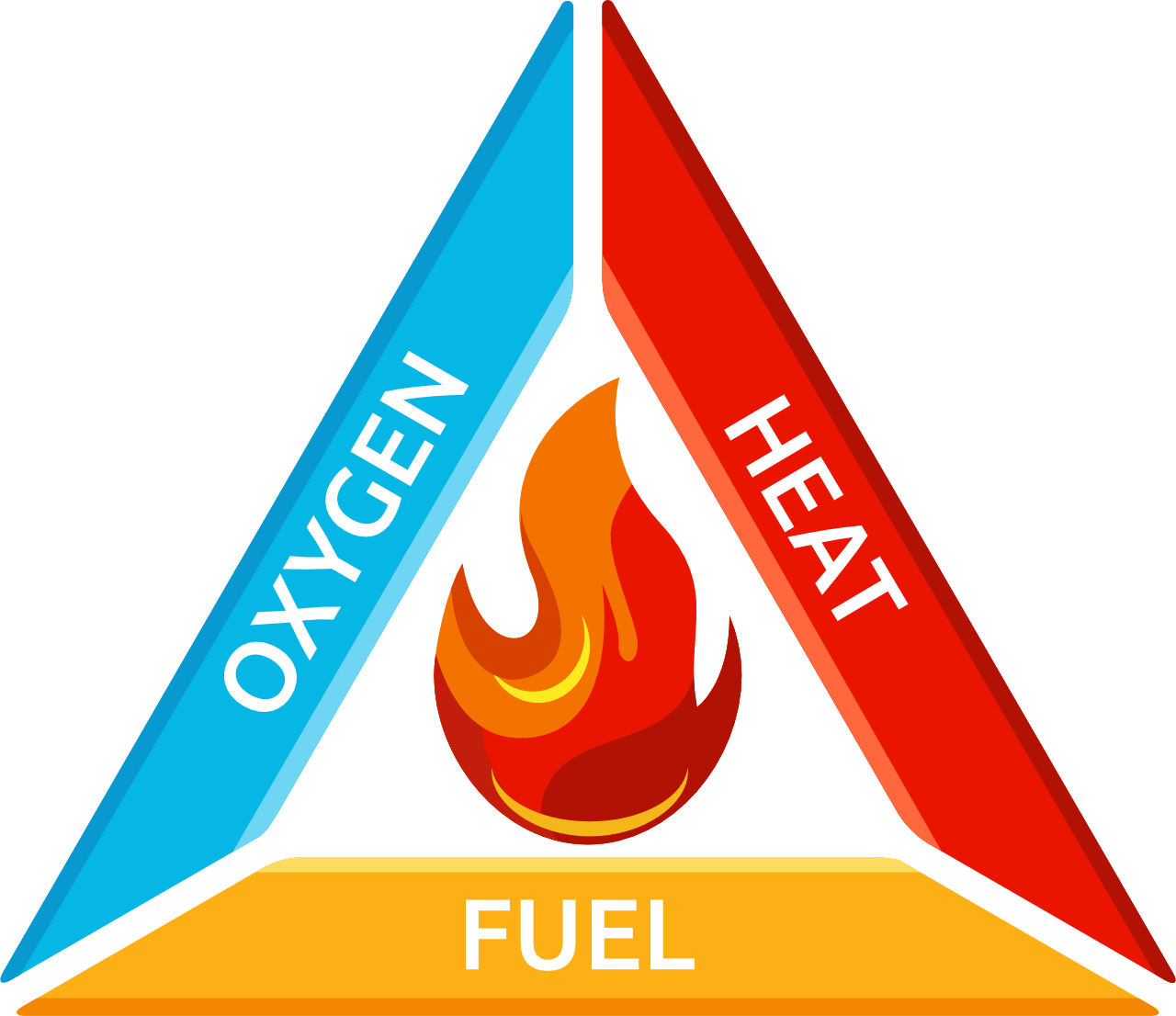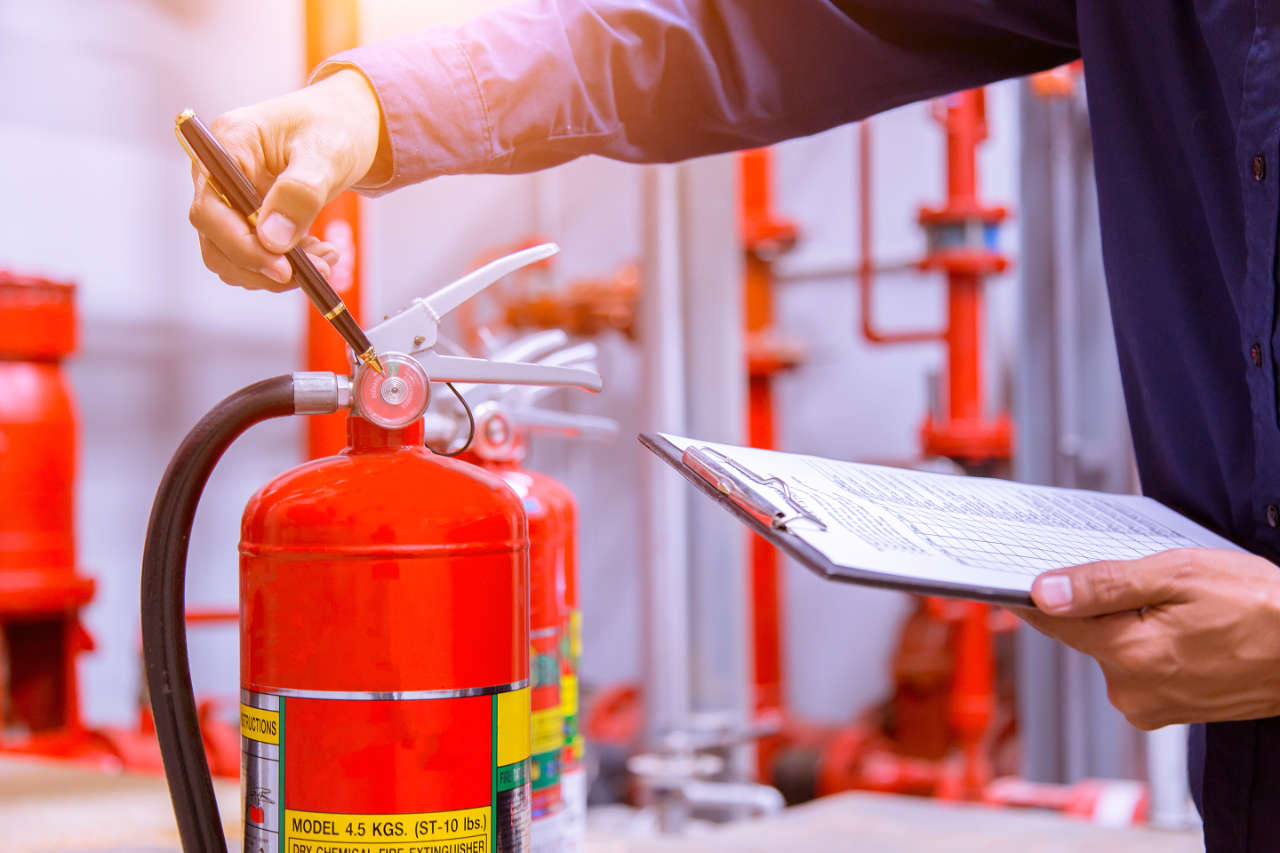
In the UK, there is an average of 22,000 workplace fires each year, with the most common causes being faulty or misused electrics and equipment. Causes of workplace fire include flammable materials not being stored properly and electrical equipment such as heaters being located too close to combustible materials.
Understanding the core components of combustion and how they react with each other can help employers inform better fire safety in workplace policies, help improve employee awareness of the causes of fire and help mitigate the risk of fire overall.
A simple way to visualise combustion is using the Fire Triangle or Fire Tetrahedron.
Read our guide on the importance of online fire safety training.
What is the Fire Triangle?
Also known as the “combustion triangle”, the Fire Triangle represents the three core components needed to ignite and sustain fires: a heat source, fuel and an oxidising agent, typically oxygen.

A triangle format demonstrates that if one of the three elements of the fire triangle is removed, a fire cannot naturally occur, and the triangle is broken.
Oxygen
- To keep burning, a fire requires oxygen.
- The air around us contains approximately 21% oxygen, providing more than the typically required 16% needed for a fire to burn.
- One way to extinguish a fire is to remove its oxygen supply. Reducing the level of oxygen outside or inside a room that isn’t airtight would not be a viable option. Other ways exist to cut off a fire’s oxygen supply such as with the appropriate fire extinguisher or fire blanket.
- These work to seal the fire from access to oxygen, extinguishing the blaze.
- Preventing access to oxygen is only required until the fire is extinguished and the risk of subsequent ignition is removed, such as reducing heat needed for combustion or removing usable fuel.
Fuel
- A fire cannot burn unless there is a fuel source.
- Fuel counts as any flammable material or chemical, such as oil, wood, paper, fabrics, plastics, gases and rubber.
- How a fuel combusts depends on several factors, including how much fuel there is, its moisture content, shape and size. These characteristics can inform the temperature at which the fuel will burn, how easily it will burn and over what period.
- Removing combustible materials from areas where heat sources are present, or placing them in secure storage, may help to minimise the fire risk.
Heat
- A fire cannot start without a heat source.
- Ignition happens when a heat source comes into contact with flammable material and oxygen, with the fuel producing flammable vapours. Typical heat sources include sparks, lit cigarettes, electric heaters and open flames.
- Once a fire has started, heat is also involved in its spread, warming the surrounding area and drying out other flammable materials nearby so they can also ignite more easily.
- Removing heat sources from an environment containing oxygen and flammable materials, or having safety policies about their usage, may help reduce the chances of a fire.
Find out about Praxis42’s fire safety awareness courses.
What is the Fire Tetrahedron?
The Fire Tetrahedron is a more complex and in-depth iteration of the Fire Triangle model.
Alongside heat, fuel and oxygen, the Fire Tetrahedron features a fourth component – the chemical chain reaction.
This model treats the chemical chain reaction that produces ignition as its own component. Fires are caused by combustion, an exothermic chemical reaction that continues to feed a fire and keeps it burning. Immediately after ignition occurs, this exothermic reaction begins and sustains the fire until one or more of the core components of the Fire Tetrahedron are removed.
For fires involving chemicals such as magnesium or titanium, a different approach is needed than other fires because of the specific chemical chain reaction. For example, water could not be used to put out this type of fire as it would increase combustion.
These are known as Class D fires.
As not all fire extinguishers and fire extinguishing methods are appropriate to fight all types of fires, understanding how a specific kind of fire behaves on a molecular level can help to understand the best way to navigate the situation safely.
Just like the Fire Triangle, if one or more of the components of the Fire Tetrahedron are removed, combustion stops, and the fire is extinguished.
Read our guide on fire safety in the workplace.
The Fire Triangle and Fire Tetrahedron in fire prevention and safety
The Fire Triangle and Fire Tetrahedron provide employers with clear visuals that can help them inform best practices regarding fire safety in the workplace.
Their information can be applied to developing these best practices, including where to store flammable materials and how to handle them properly. This includes maintenance of electrical systems and where fire suppression equipment is best placed throughout the workplace for maximum impact and efficiency.

Workplace fire suppression equipment such as fire extinguishers, sprinklers, and fire doors are designed to disrupt combustion by removing one or more components of the Fire Triangle and Fire Tetrahedron.
For example, fire sprinklers cool down any potential fuel that could catch alight and smother the fire, cutting off its oxygen supply. CO2 fire extinguishers work the same way in combatting electrical fires; the CO2 gas starves the fire of oxygen while also not conducting electricity.
Employees are on the front-line regarding fire safety and prevention in the workplace.
Fire Safety Training

Employers are required by law (The Regulatory Reform (Fire Safety) Order 2005) to provide their employees with up-to-date fire safety training, including workplace evacuation procedures, identifying potential fire risks, where the fire suppression equipment is stored and how to use it correctly.
Understanding the Fire Triangle and Fire Tetrahedron concepts should be considered a key part of this training.
Developed by experienced fire safety consultants, Praxis42’s Fire Safety Training course is an accredited e-learning course that can be completed at an employee’s own pace. Comprehensive and highly beneficial, our course applies to businesses of all sizes in all industries.
For fire marshals, we offer Fire Marshal Training which covers everything in the Fire Safety course plus the additional knowledge fire marshals specifically need for their role.
Fire safety is also covered as part of our comprehensive course, IOSH Working Safely. Participants identify the causes of fire and learn what action to take on discovering a fire or hearing a fire alarm.

Rob Sherman
Director of Fire Safety
